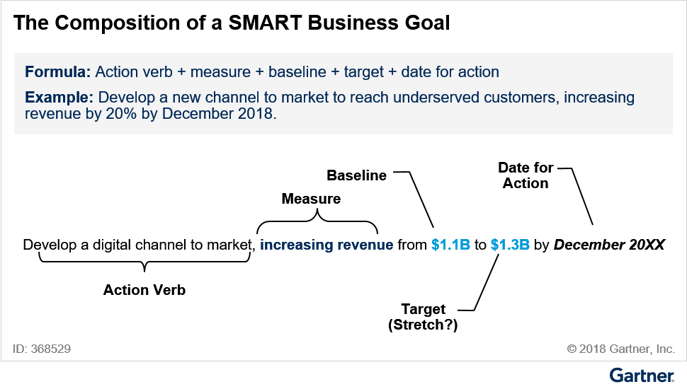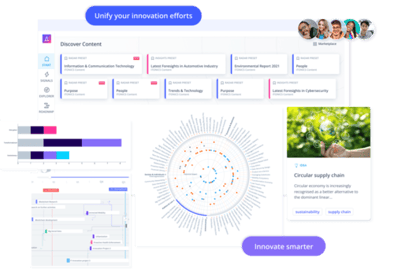Innovation is the lifeblood of progress and growth for any organization, enabling it to stay competitive and relevant in an ever-changing business landscape. However, successful innovation doesn't happen by chance; it requires careful planning, focus, and well-defined objectives and goals. In this article, we will explore the importance of clear innovation objectives and goals, their role in driving innovation success, and how to define and establish them effectively.
Innovation objectives vs. goals
Innovation objectives and goals are two critical components of a successful innovation program.
Innovation objectives are overarching statements that define the broad outcomes an organization aims to achieve through innovation, providing strategic direction and purpose.
Innovation goals are specific, measurable, and time-bound targets that serve as milestones to track progress and contribute to achieving the innovation objectives.
While innovation objectives outline the "what" and "why" of innovation, innovation goals focus on the "how much" and "by when." They work in tandem, with objectives guiding the overall vision and goals providing actionable steps to reach the desired outcomes.
Why you need innovation objectives and goals
Innovation objectives and goals provide the roadmap for an organization's innovation journey. They serve as guiding beacons, illuminating the path to success and aligning innovation efforts with the overall business strategy. Without these clear and measurable objectives, innovation initiatives can become aimless, leading to wasted resources, missed opportunities, and ultimately, failure.
According to Gartner®, a major reason why innovation programs fail is incomplete guidance. Executive leaders are often working with objectives and no goals, or goals and no objectives.
Every innovation program needs well-developed objectives and goals to improve specific innovation ability and leverage innovation capabilities.
- from Gartner® report "Leverage Enterprise Strategy Objectives and Goals to Focus Your Innovation Efforts"
Gartner further states that "A thorough understanding of the organization's specific objectives, goals, and strategies is the key first step to informing the selection of innovation activities most likely to yield the best result among the significant space of innovation options."
Well-defined innovation goals increase the potential that your innovation efforts have a high business value and impact while mitigating the risks of going in the wrong direction.
Defining objectives and goals to measure innovation performance
Gartner further states in the report that executive leaders can improve the likelihood of success for innovation initiatives by designing goals that "inform the innovation process on the outcomes of importance leading to focus, give a timeline that enables the right selection of innovation activities and determine the resources and competencies needed for success."
The SMART approach to defining innovation goals
A popular and effective method for setting clear and actionable goals is the SMART approach. SMART stands for Specific, Measurable, Achievable, Relevant, and Time-bound. Let's delve into each element of the SMART framework:
- Specific:
Innovation goals must be specific and well-defined, leaving no room for ambiguity. Vague goals make it challenging for teams to focus their efforts and align with the organization's strategic vision. Being specific helps articulate exactly what needs to be achieved and by what means. - Measurable:
Measurable goals provide a quantifiable metric for tracking progress and success. Establishing key performance indicators (KPIs) allows organizations to gauge the effectiveness of their innovation initiatives and make data-driven decisions. - Achievable: Goals should be challenging yet realistic. Setting unattainable targets can demotivate teams, while easily achievable ones might not drive significant progress. Finding the right balance ensures that teams are inspired to push their boundaries while maintaining a sense of accomplishment.
- Relevant:
Relevance is crucial to ensure that the innovation goals align with the organization's overall strategy and long-term vision. Goals that are aligned with the business context drive meaningful outcomes and contribute to the organization's success. - Time-bound:
Setting a specific timeframe for achieving goals provides a sense of urgency and helps prevent complacency. Deadlines create a sense of accountability and encourage teams to stay on track, fostering a culture of innovation with a focus on timely delivery.
The Gartner Composition of a SMART Business Goal (Figure 2) portrays a well-framed goal, illustrated with a practical example. According to Gartner,"Goals that do not include all these elements will likely misguide the innovation process, possibly driving too large a scope or disestablishing the timeline."

6 steps for defining and establishing clear innovation objectives and goals
To pave the way for successful innovation programs, follow these six steps when defining your objectives and goals:
1. Conduct a strategic assessment
Begin by conducting a comprehensive assessment of your organization's current strategic priorities, vision, and long-term goals. Understand the challenges, opportunities, and market trends that impact your business. This assessment will form the foundation for defining innovation objectives and goals that align with your strategic direction.
2. Involve stakeholders and team members
Innovation is a collective effort that involves various stakeholders and team members. Engage key decision-makers, executives, innovation champions, and cross-functional teams in the goal-setting process. This collaboration ensures that the goals reflect diverse perspectives and expertise, leading to a more robust and holistic approach.
3. Prioritize and focus
While innovation can encompass a wide range of possibilities, it's essential to prioritize and focus on areas that align with your organization's core competencies and strategic objectives. Setting too many goals can dilute resources and attention, so it's better to concentrate on a few key objectives that will have the most significant impact.
4. Apply the SMART framework
Using the SMART approach, convert your prioritized objectives into actionable goals. Ensure each goal meets the specific, measurable, achievable, relevant, and time-bound criteria. For example, if the objective is to "enhance customer engagement," a SMART goal could be "Increase customer satisfaction scores by 15% within the next six months through improved customer support channels."
5. Communicate and cascade goals
Effective communication is crucial in gaining buy-in and commitment from all stakeholders. Cascade the defined innovation goals throughout the organization, ensuring that every team and individual understands their role in achieving these objectives. Regularly communicate progress, celebrate successes, and address challenges to maintain momentum.
6. Monitor progress and adapt
Setting innovation goals is not a one-time exercise; it requires continuous monitoring and adaptation. Regularly track the progress of each goal, analyze data and feedback, and make necessary adjustments when required. Embrace a culture that encourages learning from failures and using insights to drive continuous improvement.
Clear innovation objectives and goals are the pillars of successful innovation programs. By embracing the SMART framework and involving key stakeholders in the goal-setting process, organizations can align their innovation efforts with strategic priorities, foster a culture of creativity and agility, and drive transformative growth.
Remember, the journey towards innovation excellence is ongoing—continuously monitor progress, adapt to changes, and celebrate achievements along the way. With a well-defined innovation roadmap, your organization will be better equipped to tackle challenges, seize opportunities, and thrive in an ever-evolving business landscape.
Your digital tool to boost innovation success - from strategy to execution
Software plays a crucial role in facilitating and enhancing the process of defining clear innovation objectives and goals. As organizations embrace digital transformation and seek more efficient ways to manage innovation, innovation management software becomes an invaluable tool for several reasons:
- Centralized collaboration
- Data-driven insights
- Enhanced goal setting
- Progress monitoring
- Idea management
- Resource allocation
- Reporting and accountability
- Scalability and flexibility
The ITONICS Innovation OS offers powerful features that support the above-mentioned aspects. ITONICS supports clients like adidas, Intel, Johnson & Johnson, Cisco, or KPMG with end-to-end innovation management software, supporting innovation activities from strategy to execution, all on one central platform.
Learn more in our demo video, or get a free demo with one of our experts today!

See the ITONICS Innovation OS in action
Have more time?
- Read Why Innovation Programs Fail and How to Ensure Yours Don’t
- Read Aligning Innovation Activities with Strategy Using Roadmaps
- Read Your Systematic Framework For Establishing An Innovation Function
Disclaimer
Gartner, Leverage Enterprise Strategy Objectives and Goals to Focus Your Innovation Efforts, Darren Topham, Peter Skyttegaard, Refreshed 4 May 2022, Published 3 December 2020
GARTNER is a registered trademark and service mark of Gartner, Inc. and/or its affiliates in the U.S. and internationally and is used herein with permission. All rights reserved.
This graphic was published by Gartner, Inc. as part of a larger research document and should be evaluated in the context of the entire document. The Gartner document is available upon request from ITONICS.











